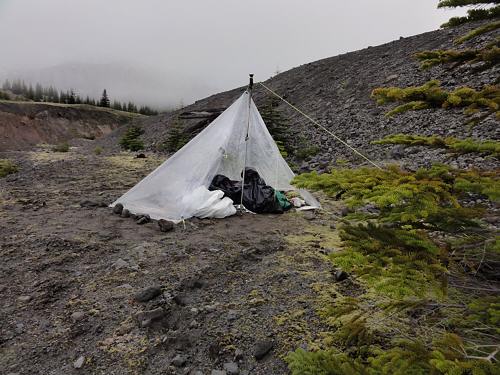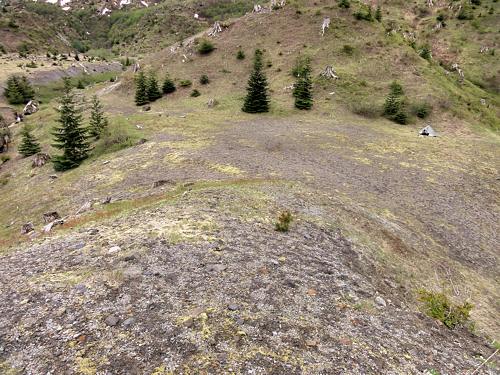Trying it the old way.
First morning. Gray and damp.
I just completed a four day backpacking trip to Mt St Helens. I wanted to go have another look at a place I got to last year. Which I did, sort of, but with snow pack at two to three times normal, the end of June this year is not a third of the way through backpacking season, but pre-season.
A few years back, I drove in on April 30 and went hiking anywhere I wanted. The only snow then was up where only climbers would go, not anywhere that sane hikers would have trouble with it.
And so it was for the first several years that I spent exploring the area.
No longer. This is the fourth year running that heavy snow has pushed the hiking season out toward autumn. It looks like the window for real backpacking will again be only two or three weeks long.
Lumpy and snowy and foggy.
Bummer.
But it wasn't all bad this trip because I was expecting to deal with snow. Not so much, but some.
I also knew that where I'd be going I'd have no chance to use my hammock.
In places there are trees tall enough and thick enough to support a hammock, but those trees grow in only a few spaces. They are bushy, hard to hang from. And their trunks are covered with blisters that pop open under pressure and ooze a thick, sticky sap that smells like turpentine.
Transparent. Nice in the moonlight. A real dew-catcher.
The smell is fine. It's a strong, clean smell, but the stickiness isn't.
Get this stuff on your hands and it won't come off. Get it on the suspension of your hammock and it's worse. It hardens and though alcohol will remove it from hands, and spots of it from clothing, if your hammock suspension gets saturated with it, you have to let it harden and just live with it.
So anyway, I had a piece of plastic I wanted to play with. I used it once as an 8x10 tarp, then cut it down to make a sort of tent-like shelter. I took that.
As a backup I took my home-made Brawny Shelter, a.k.a. Dancing Light Gear Tacoma.
Seemed to keep the werewolves away too.
The short of it: I missed the hammock. A lot.
I'm way past the days when I can sleep on the ground comfortably. A couple of years ago I talked to Ron Moak of Six Moon Designs, who said that he doesn't even use a sleeping pad. Apparently just a waterproof sheet beneath him, and he gets by OK.
Could have been pitched better though.
Go, Ron.
I have enough wrong with my back, plus a heap of years piled on top that I can't sleep more than two hours on the ground without awakening from the pain. In a hammock I can just snore my way through the whole night.
Night two. Slight clearing.
But hammocks aren't perfect either.
A big hammock tarp will catch the wind. A smaller tarp catches less wind but gives less protection from both wind and rain. Being above ground level you're up higher where there is more wind. This is colder, and hammock insulation is tricky.
You are also tree-dependent. You need the right size and type of trees, and need two that are just far enough apart, and oriented right so you can protect yourself from wind and weather.
Hammocks are places to sleep, not homes. You can't wait out a day-long storm in a hammock. You can't really change clothes in one, and can't spread out your gear for convenience or for anything else. You also have more limited sleeping positions. No sleeping on your stomach, and though sleeping on your side is possible it isn't that convenient.
Not as lumpy. Almost grassy.
But there are huge positives too.
A hammock is independent of the ground. You can sleep over rocks, mud, logs, or trickles of water. You are above the night-dampness. In tree country you have many more potential camp sites, even on severe slopes, and you stay well above critters like ants, spiders, centipedes, mice, wood rats, ground squirrels, snakes, and skunks.
Setup is simple. As is takedown.
I have a fabric tube (which Tom Hennessy calls "snakeskins") that I carry the hammock in. After stringing it up, I slide this off the hammock, and unfurl the tarp. Takedown goes the other way -- I just slip this tube back over the hammock and tarp, and I have all the loose ends magically contained in a long, loosely packed bundle that's easy to arrange in the pack.
You can't be this messy with a hammock.
Using single-wall tents the last few days I had a chance to refresh myself on dealing with them.
Setup is annoyingly complicated. If I had to use a tent all the time I'd get a freestanding tent or design one. Fumbling with stakes and line three nights running made me crazy. Keeping track of the pieces too. It's really easy to lose one or more stakes any time. The lines always get tangled.
Finding a place to pitch a shelter is insane. The ground is either lumpy or at too great a slope or both, and if you find a place that works, it may be too exposed to weather or too crowded by trees and shrubs, or you have to orient the shelter facing the wind rather than away from it. You usually end up sleeping on some odd slope, either sliding or rolling downhill in your sleep.
Tent on lonesome flat, at top right.
Critters can just walk right in.
And it's damp. I had extremely heavy condensation all three nights. The ground was damp, the air cool and damp, dew collected on everything, and I was right in the middle of it. Ventilation was no help.
In the morning I had a dripping, slimy, grit-covered shelter and dangling stray lines to fold and pack away. By the next evening I had a still-dripping, slimy, grit-covered shelter to set up again, except that all the lines had gotten tangled.
For those who like sleeping on the ground, though, a carefully-chosen shelter can be the lightest way to go by far. You don't depend on finding the right trees in the right area. You have a wider variety of shelters to choose from, and you can get one at almost zero cost if using plastic sheeting, though that option is heavier than modern fabrics.
Slight clearing that later became more mist.
Tent-like shelters are easier to understand, and more familiar, and can sleep two, or three, or four at a time. They are also easier to repair, and to work around in case there is some kind of catastrophic failure. Rip the bottom of your hammock and you're screwed. Rip your tent and you can at least use the remaining part as a waterproof blanket.
Ultimately it comes down to what a person likes and can deal with.
I've done both. I'm glad I've had the experience of using a hammock and look forward to getting back to it on the next trip.
That's me. Other people like other things and that's fine too. I'm glad we have choices.
More, If you make your own:
Fibraplex/Raptor Resins
Qwik-E-Tent
Trailquest
See tabs at the top for definitions and books.
Have extra info to add?
If the commenting system is out again, then email sosayseff@gmail.com
Me? Recently nominated for this year's Doofus Awards. (Next year's too.)









